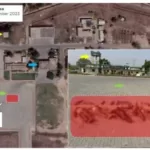The United Nations has raised alarm over the dire situation facing children in Gaza as Israeli airstrikes target a school serving as a shelter, and tensions grow over the civilian toll of the conflict.
After nearly four weeks of war, more than 40% of casualties in Gaza are children, according to the UN. The toll stands at 3,900 reported child victims, with an additional 1,250 children presumed buried under the rubble. With limited rescue capabilities and overwhelmed hospitals facing shortages, the chances of survival for those trapped in debris are tragically low.
A joint statement from agencies supporting children, women, health services, and Palestinian refugees underlines that “women, children, and newborns in Gaza are disproportionately bearing the burden” of the month-long conflict.
The conflict began on October 7 when Israel declared war on Hamas following an attack that left 1,400 people dead, predominantly civilians. Since then, Israel has launched an unprecedented number of airstrikes and encircled Gaza City.
The number of children killed in this conflict surpasses the total recorded by the UN for years of previous conflict in Gaza. Between 2008 and September 2023, 859 boys and girls lost their lives in airstrikes and fighting within Gaza. In the past 29 days, an average of 130 children have been killed daily.
While these casualty figures come from Gaza’s health authorities, which are controlled by Hamas, the UN has historically found their data to be broadly accurate.
The most vulnerable are newborns who came into the world amidst the chaos. With an estimated 50,000 pregnant women in Gaza and many hospitals and clinics closed, some women have no choice but to give birth in shelters or amid the rubble.
Even children in hospitals face heightened risks as supplies dwindle and sanitation conditions worsen. The UN has expressed concern for 130 premature babies in incubators.
International pressure on Israel is mounting, even from its close ally, the United States. US Secretary of State Antony Blinken called for greater protection of civilians, despite rejecting calls for a ceasefire.
Currently, small convoys are only able to deliver limited supplies daily, doing little to alleviate food, medicine, and water shortages, and addressing none of the critical infrastructure destruction.
Efforts are underway to propose humanitarian pauses of six to 12 hours daily to allow aid delivery and casualty evacuation. These initiatives also aim to secure the release of women and elderly prisoners in exchange for hostages held by Hamas, although Israel’s willingness to accept these terms remains uncertain.
Leaders in the region are pushing for a ceasefire, warning of the potential for further deterioration. In contrast, Israel and its allies argue that a ceasefire would enable Hamas to regroup and launch new attacks.
Israel’s defense minister, Yoav Gallant, emphasized the “fierce battles” within Gaza, reiterating the goal of “crushing” Hamas by the end of the war.
Israeli officials have defended strikes on civilian targets, including refugee camps and medical facilities, by claiming that they concealed Hamas positions.
Tragically, an attack on a UN school housing thousands occurred on Saturday, resulting in casualties. Additionally, Nasser Hospital in Gaza City was struck, causing further loss of life.
Israel has opened a “humanitarian route” for a limited time to allow civilians to move to safer locations. However, the challenges remain immense.
As this conflict unfolds, it has profound implications for millions of lives in the Middle East and beyond, and it continues to evolve as a critical international issue.





